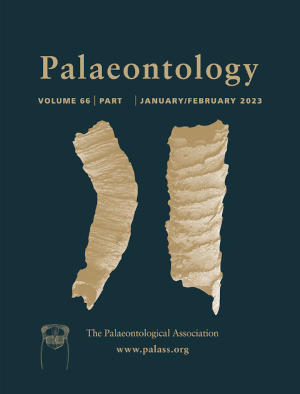Article: Rise and fall of the phacopids: the morphological history of a successful trilobite family
Publication: Palaeontology
Volume:
66
Part:
5
Publication Date:
2023
Article number:
e12673
Author(s):
Valentin Bault, Catherine Crônier, Claude Monnet, Diego Balseiro, Fernanda Serra, Beatriz Waisfeld, Arnaud Bignon, and Juan José Rustán
Abstract
Abstract Phacopidae were a successful family of the Silurian–Devonian period. Although their diversity trends are well identified, their shape evolution is unknown; their morphology often considered to be conservative. We have quantified these morphologies using geometric morphometrics (landmarks) and investigated their evolution using morphological disparity indices. Results identified morphological variations between the genera, and through time. Phacopids differ from each other by the position of the facial suture linked to the size of the visual complex, the shape of the genal angle and the elongation of both cephalon and pygidium. The morphological disparity of cephala was high from the Silurian, contrary to that of pygidia. Subsequently, the morphological disparity increased in the Early Devonian with the development of narrow cephala and triangular pygidia. Morphological disparity was greater in the Emsian for both cephala and pygidia, more than 50 myr after the origination of phacopids. It constituted a perfect example illustrating that a peak of biodiversity does not necessarily happen in the early history of a clade. Subsequently, a strong decrease of morphological disparity occurred in the Middle Devonian, in conjunction with sea-level changes and anoxic events. Taxonomic richness and morphological disparity declined strongly in the Givetian, in a non-random extinction affecting particularly blind genera. The morphological disparity remained low in the Frasnian despite progressive eye reduction influenced by environmental changes. An extensive recovery occurred in the Famennian with an important increase of both taxonomic and morphological diversity. The Hangenberg event caused the final extinction of phacopids.
